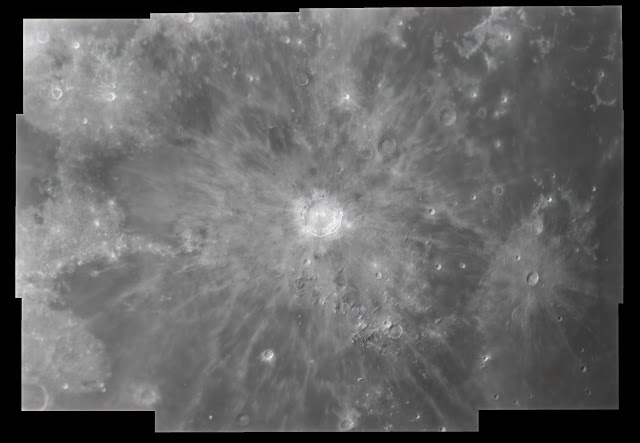Lunar rays, streaks of debris radiating out from craters, are among the few structures better seen during a full moon than a partial phase
Technically, there are 2 other types of lunar rays:
1. rays of light shining through a break in a lunar mountain range/crater during lunar sunrise. these esoteric phenomena are challenges for advanced lunar observers and difficult to catch.
2. a bunch of dudes named Ray something...(sorry)
The massive ray structure around tycho (lower right below) is easily seen though binoculars:
 |
| massive lunar rays surrounding tycho (right below center) copernicus and kepler (middle, below center) full moon 11/27/12 |
The butterfly pattern around crater proclus suggests a low angle impact:
 |
| lunar rays around crater proclus 8/29/2023 06:42 UTC (click for full size) top full moon picture above |
 |
| Menelaus and rays 8/29/23 06:59 UTC (click for full size) upper mid left full moon image |
craters messier a and b are thought to have formed by a single impacting body coming in at a very low angle:
 |
| Messier A and B 8/29/23 06:48 UTC upper right full moon image |
Here's a mosaic of craters copernicus and kepler and surrounding rays. (left the rough edges for the mosaic feel). click for a moon walk:
 |
| Copernicus and Kepler 9 panel mosaic 8/29/23 07:05-07:17 UTC (click for massive size) |
Imaging details:
camera ZWO ASI 290MM with 850 nm IR pass filter
celestron 11" Edge HD
mediocre seeing
8/29/23 06:41-07:17 UTC
East Bluff, CA
captured in fire capture
stacked in autostakkert
mosaic in maxim (tried and true worked amazingly well)
topaz denoise worked wonders for slight noise reduction and dramatic detail recovery
(first sharpening has ever worked well for me in topaz)
low light
remove noise 1
enhance sharpness 63
No comments:
Post a Comment